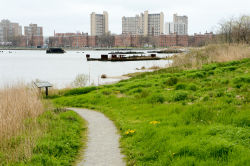Calvert Vaux Park
Calvert Vaux Park
What was here before?
The Coney Island Creek that runs through the park was once home to small ports and shipyards, and in the early 20th Century was reputedly a rumrunners’ haven. Today the hulls of nearly two dozen shipwrecks can occasionally be seen in the creek at low tide, including a half-submerged yellow submarine built by shipyard worker Jerry Bianco, Quester I, which capsized upon launch in 1970.
How did this site become a park?
The land for this park was obtained through three land acquisitions. In 1933, the Dreier-Offerman Home for unwed mothers and children closed and donated its property to NYC Parks. In appreciation, Parks originally named it Dreier-Offerman Park. In 1962, NYC Parks simultaneously acquired two additional parcels: a small strip of land and a 72-acre tract consisting of property and landfill debris excavated during the construction of the Verrazano-Narrows Bridge. This last acquisition, financed by a 1960 New York State bond act, provided the bulk of the park’s property. In 1998, NYC Parks renamed this open space in honor of distinguished designer Calvert Vaux.
In 2000, NYC Parks rebuilt the playground and added a new public restroom, open lawns, a children’s play area, basketball courts, and a children’s spray shower.
In 2007, Calvert Vaux Park was selected for restoration as part of the City’s PlaNYC initiative, in which eight parks citywide were transformed into attractive regional destinations. The master plan proposal included kayak launches, a central lawn, nature trails, an amphitheater, a playground, a recreation center, and a pavilion. One of the parks' central attractions is the Verrazano Sports Complex, a competitive soccer, and baseball center.
Who is this park named for?
The park is named after Calvert Vaux (1824-1895), the noted Victorian-era architect and pioneering landscape architect who co-designed Central and Prospect Parks.
Vaux was born in England and moved to America to study with leading architect in the nation, Andrew Jackson Downing (1815-1852). He designed private homes, apartment complexes, public housing, and many public institutions, as among these the American Museum of Natural History and the Metropolitan Museum of Art in the Gothic and Victorian style. His partnership with Frederick Law Olmsted (1822-1903) generated designs for Central Park, Prospect Park, Morningside Park, and Fort Greene Park. Vaux drowned under mysterious circumstances, and his body was found in nearby Gravesend Bay.
Check out your park's Vital Signs
Clean & Safe
Green & Resilient
Empowered & Engaged Users
Share your feedback or learn more about how this park is part of a
Vital Park System





